Analysis of Transportation Laws: Vehicle Regulations in Australia
VerifiedAdded on 2023/04/20
|20
|5375
|426
Report
AI Summary
This report provides an overview of transportation laws and regulations in Australia. It discusses the importance of a safe and efficient transportation system and the role of road transportation in the country. The report highlights the various government regulatory departments, such as the Bureau of Infrastructure, Transport and Regional Economics (BITRE) and the National Heavy Vehicle Regulator (NHVR), responsible for implementing rules and regulations for different vehicle categories. It covers the Australian Design Rules (ADRs), Australian Road Rules (ARRs) for cars, motorbikes, and cycles, and the Heavy Vehicle National Law (HVNL) for buses, coaches, and other heavy vehicles. Additionally, it touches upon the Australian Light Vehicle Standards Rules (ALVSRs) and their relationship with the ADRs. The report aims to provide a comprehensive understanding of the legal framework governing transportation in Australia.
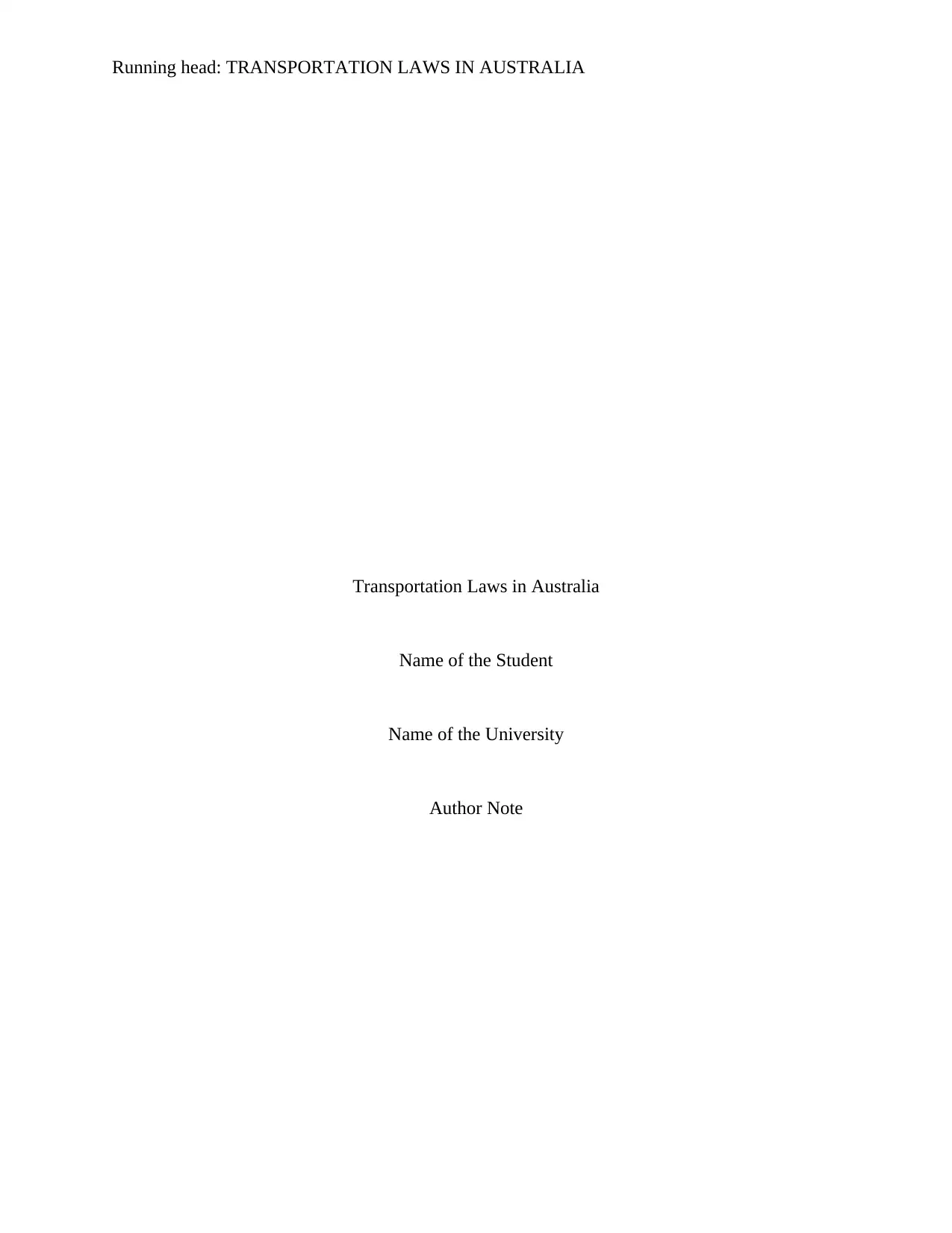
Running head: TRANSPORTATION LAWS IN AUSTRALIA
Transportation Laws in Australia
Name of the Student
Name of the University
Author Note
Transportation Laws in Australia
Name of the Student
Name of the University
Author Note
Paraphrase This Document
Need a fresh take? Get an instant paraphrase of this document with our AI Paraphraser
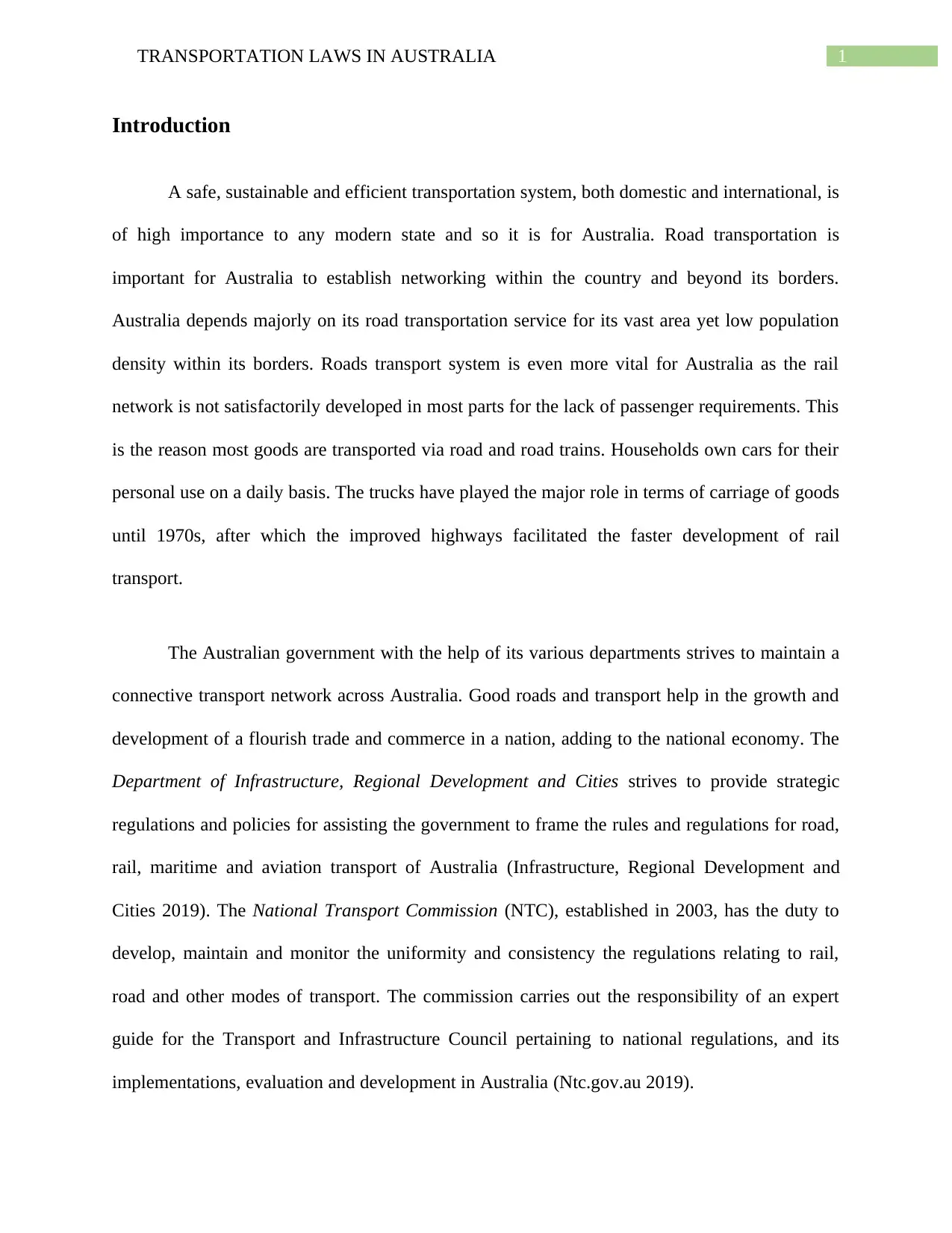
1TRANSPORTATION LAWS IN AUSTRALIA
Introduction
A safe, sustainable and efficient transportation system, both domestic and international, is
of high importance to any modern state and so it is for Australia. Road transportation is
important for Australia to establish networking within the country and beyond its borders.
Australia depends majorly on its road transportation service for its vast area yet low population
density within its borders. Roads transport system is even more vital for Australia as the rail
network is not satisfactorily developed in most parts for the lack of passenger requirements. This
is the reason most goods are transported via road and road trains. Households own cars for their
personal use on a daily basis. The trucks have played the major role in terms of carriage of goods
until 1970s, after which the improved highways facilitated the faster development of rail
transport.
The Australian government with the help of its various departments strives to maintain a
connective transport network across Australia. Good roads and transport help in the growth and
development of a flourish trade and commerce in a nation, adding to the national economy. The
Department of Infrastructure, Regional Development and Cities strives to provide strategic
regulations and policies for assisting the government to frame the rules and regulations for road,
rail, maritime and aviation transport of Australia (Infrastructure, Regional Development and
Cities 2019). The National Transport Commission (NTC), established in 2003, has the duty to
develop, maintain and monitor the uniformity and consistency the regulations relating to rail,
road and other modes of transport. The commission carries out the responsibility of an expert
guide for the Transport and Infrastructure Council pertaining to national regulations, and its
implementations, evaluation and development in Australia (Ntc.gov.au 2019).
Introduction
A safe, sustainable and efficient transportation system, both domestic and international, is
of high importance to any modern state and so it is for Australia. Road transportation is
important for Australia to establish networking within the country and beyond its borders.
Australia depends majorly on its road transportation service for its vast area yet low population
density within its borders. Roads transport system is even more vital for Australia as the rail
network is not satisfactorily developed in most parts for the lack of passenger requirements. This
is the reason most goods are transported via road and road trains. Households own cars for their
personal use on a daily basis. The trucks have played the major role in terms of carriage of goods
until 1970s, after which the improved highways facilitated the faster development of rail
transport.
The Australian government with the help of its various departments strives to maintain a
connective transport network across Australia. Good roads and transport help in the growth and
development of a flourish trade and commerce in a nation, adding to the national economy. The
Department of Infrastructure, Regional Development and Cities strives to provide strategic
regulations and policies for assisting the government to frame the rules and regulations for road,
rail, maritime and aviation transport of Australia (Infrastructure, Regional Development and
Cities 2019). The National Transport Commission (NTC), established in 2003, has the duty to
develop, maintain and monitor the uniformity and consistency the regulations relating to rail,
road and other modes of transport. The commission carries out the responsibility of an expert
guide for the Transport and Infrastructure Council pertaining to national regulations, and its
implementations, evaluation and development in Australia (Ntc.gov.au 2019).
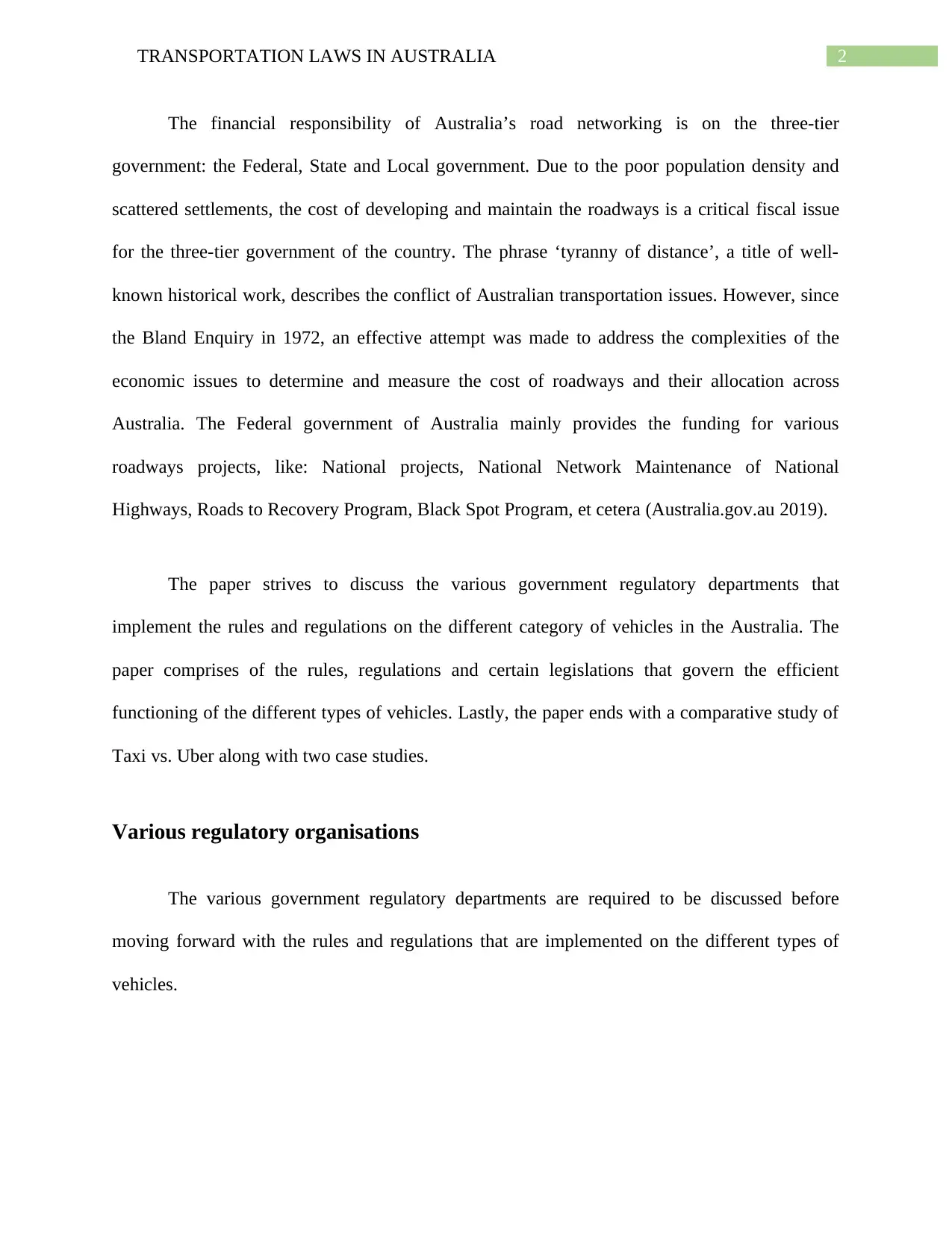
2TRANSPORTATION LAWS IN AUSTRALIA
The financial responsibility of Australia’s road networking is on the three-tier
government: the Federal, State and Local government. Due to the poor population density and
scattered settlements, the cost of developing and maintain the roadways is a critical fiscal issue
for the three-tier government of the country. The phrase ‘tyranny of distance’, a title of well-
known historical work, describes the conflict of Australian transportation issues. However, since
the Bland Enquiry in 1972, an effective attempt was made to address the complexities of the
economic issues to determine and measure the cost of roadways and their allocation across
Australia. The Federal government of Australia mainly provides the funding for various
roadways projects, like: National projects, National Network Maintenance of National
Highways, Roads to Recovery Program, Black Spot Program, et cetera (Australia.gov.au 2019).
The paper strives to discuss the various government regulatory departments that
implement the rules and regulations on the different category of vehicles in the Australia. The
paper comprises of the rules, regulations and certain legislations that govern the efficient
functioning of the different types of vehicles. Lastly, the paper ends with a comparative study of
Taxi vs. Uber along with two case studies.
Various regulatory organisations
The various government regulatory departments are required to be discussed before
moving forward with the rules and regulations that are implemented on the different types of
vehicles.
The financial responsibility of Australia’s road networking is on the three-tier
government: the Federal, State and Local government. Due to the poor population density and
scattered settlements, the cost of developing and maintain the roadways is a critical fiscal issue
for the three-tier government of the country. The phrase ‘tyranny of distance’, a title of well-
known historical work, describes the conflict of Australian transportation issues. However, since
the Bland Enquiry in 1972, an effective attempt was made to address the complexities of the
economic issues to determine and measure the cost of roadways and their allocation across
Australia. The Federal government of Australia mainly provides the funding for various
roadways projects, like: National projects, National Network Maintenance of National
Highways, Roads to Recovery Program, Black Spot Program, et cetera (Australia.gov.au 2019).
The paper strives to discuss the various government regulatory departments that
implement the rules and regulations on the different category of vehicles in the Australia. The
paper comprises of the rules, regulations and certain legislations that govern the efficient
functioning of the different types of vehicles. Lastly, the paper ends with a comparative study of
Taxi vs. Uber along with two case studies.
Various regulatory organisations
The various government regulatory departments are required to be discussed before
moving forward with the rules and regulations that are implemented on the different types of
vehicles.
⊘ This is a preview!⊘
Do you want full access?
Subscribe today to unlock all pages.

Trusted by 1+ million students worldwide
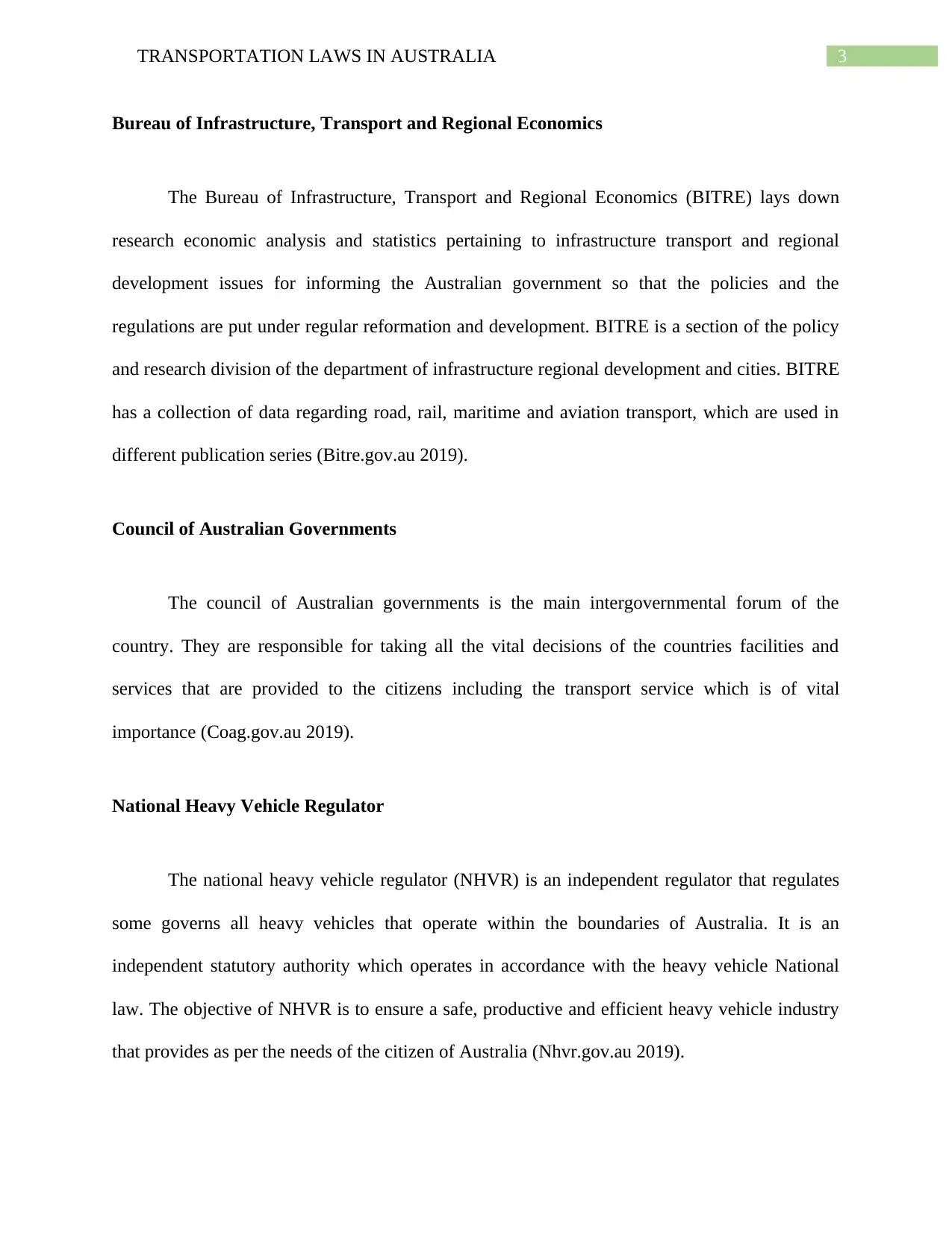
3TRANSPORTATION LAWS IN AUSTRALIA
Bureau of Infrastructure, Transport and Regional Economics
The Bureau of Infrastructure, Transport and Regional Economics (BITRE) lays down
research economic analysis and statistics pertaining to infrastructure transport and regional
development issues for informing the Australian government so that the policies and the
regulations are put under regular reformation and development. BITRE is a section of the policy
and research division of the department of infrastructure regional development and cities. BITRE
has a collection of data regarding road, rail, maritime and aviation transport, which are used in
different publication series (Bitre.gov.au 2019).
Council of Australian Governments
The council of Australian governments is the main intergovernmental forum of the
country. They are responsible for taking all the vital decisions of the countries facilities and
services that are provided to the citizens including the transport service which is of vital
importance (Coag.gov.au 2019).
National Heavy Vehicle Regulator
The national heavy vehicle regulator (NHVR) is an independent regulator that regulates
some governs all heavy vehicles that operate within the boundaries of Australia. It is an
independent statutory authority which operates in accordance with the heavy vehicle National
law. The objective of NHVR is to ensure a safe, productive and efficient heavy vehicle industry
that provides as per the needs of the citizen of Australia (Nhvr.gov.au 2019).
Bureau of Infrastructure, Transport and Regional Economics
The Bureau of Infrastructure, Transport and Regional Economics (BITRE) lays down
research economic analysis and statistics pertaining to infrastructure transport and regional
development issues for informing the Australian government so that the policies and the
regulations are put under regular reformation and development. BITRE is a section of the policy
and research division of the department of infrastructure regional development and cities. BITRE
has a collection of data regarding road, rail, maritime and aviation transport, which are used in
different publication series (Bitre.gov.au 2019).
Council of Australian Governments
The council of Australian governments is the main intergovernmental forum of the
country. They are responsible for taking all the vital decisions of the countries facilities and
services that are provided to the citizens including the transport service which is of vital
importance (Coag.gov.au 2019).
National Heavy Vehicle Regulator
The national heavy vehicle regulator (NHVR) is an independent regulator that regulates
some governs all heavy vehicles that operate within the boundaries of Australia. It is an
independent statutory authority which operates in accordance with the heavy vehicle National
law. The objective of NHVR is to ensure a safe, productive and efficient heavy vehicle industry
that provides as per the needs of the citizen of Australia (Nhvr.gov.au 2019).
Paraphrase This Document
Need a fresh take? Get an instant paraphrase of this document with our AI Paraphraser
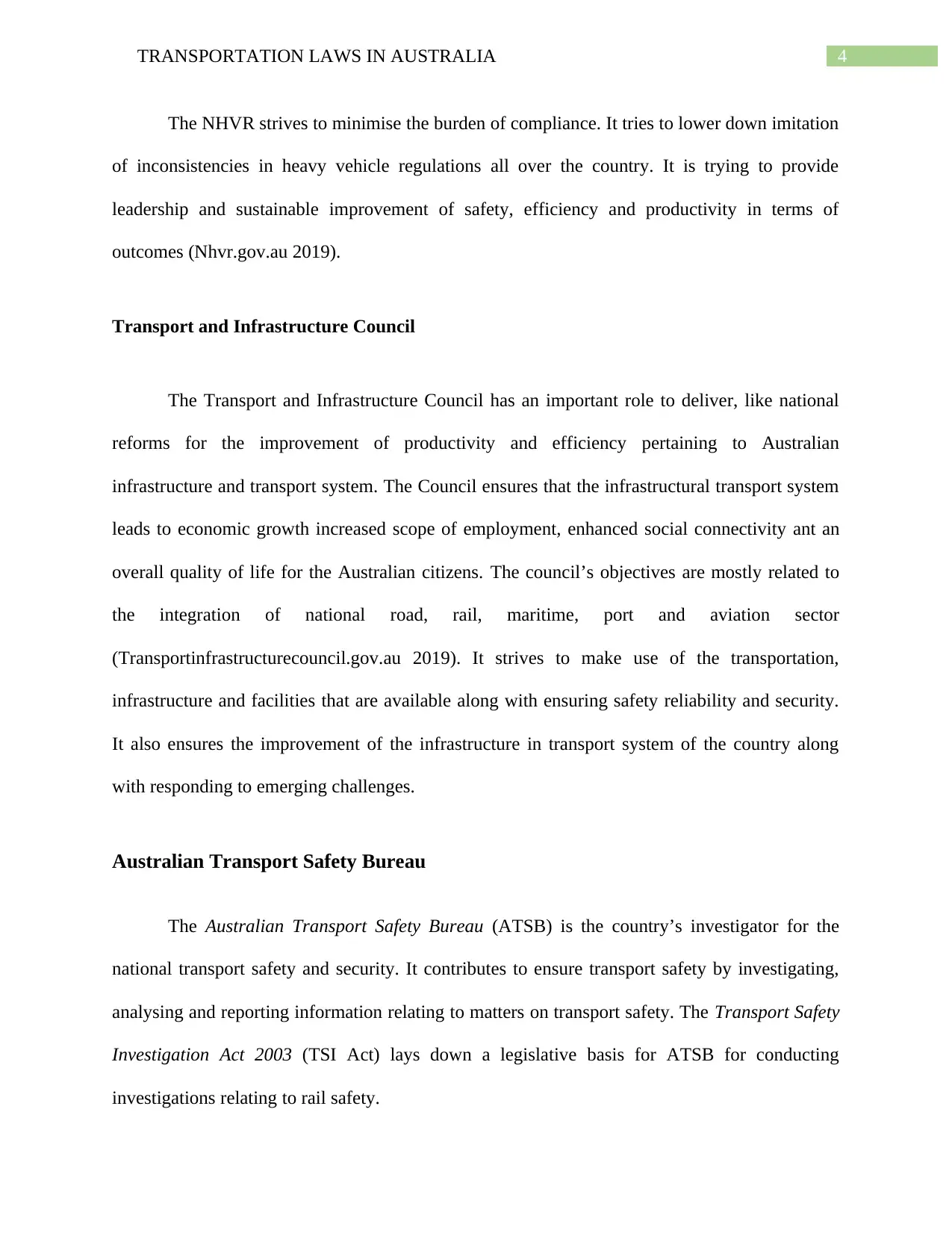
4TRANSPORTATION LAWS IN AUSTRALIA
The NHVR strives to minimise the burden of compliance. It tries to lower down imitation
of inconsistencies in heavy vehicle regulations all over the country. It is trying to provide
leadership and sustainable improvement of safety, efficiency and productivity in terms of
outcomes (Nhvr.gov.au 2019).
Transport and Infrastructure Council
The Transport and Infrastructure Council has an important role to deliver, like national
reforms for the improvement of productivity and efficiency pertaining to Australian
infrastructure and transport system. The Council ensures that the infrastructural transport system
leads to economic growth increased scope of employment, enhanced social connectivity ant an
overall quality of life for the Australian citizens. The council’s objectives are mostly related to
the integration of national road, rail, maritime, port and aviation sector
(Transportinfrastructurecouncil.gov.au 2019). It strives to make use of the transportation,
infrastructure and facilities that are available along with ensuring safety reliability and security.
It also ensures the improvement of the infrastructure in transport system of the country along
with responding to emerging challenges.
Australian Transport Safety Bureau
The Australian Transport Safety Bureau (ATSB) is the country’s investigator for the
national transport safety and security. It contributes to ensure transport safety by investigating,
analysing and reporting information relating to matters on transport safety. The Transport Safety
Investigation Act 2003 (TSI Act) lays down a legislative basis for ATSB for conducting
investigations relating to rail safety.
The NHVR strives to minimise the burden of compliance. It tries to lower down imitation
of inconsistencies in heavy vehicle regulations all over the country. It is trying to provide
leadership and sustainable improvement of safety, efficiency and productivity in terms of
outcomes (Nhvr.gov.au 2019).
Transport and Infrastructure Council
The Transport and Infrastructure Council has an important role to deliver, like national
reforms for the improvement of productivity and efficiency pertaining to Australian
infrastructure and transport system. The Council ensures that the infrastructural transport system
leads to economic growth increased scope of employment, enhanced social connectivity ant an
overall quality of life for the Australian citizens. The council’s objectives are mostly related to
the integration of national road, rail, maritime, port and aviation sector
(Transportinfrastructurecouncil.gov.au 2019). It strives to make use of the transportation,
infrastructure and facilities that are available along with ensuring safety reliability and security.
It also ensures the improvement of the infrastructure in transport system of the country along
with responding to emerging challenges.
Australian Transport Safety Bureau
The Australian Transport Safety Bureau (ATSB) is the country’s investigator for the
national transport safety and security. It contributes to ensure transport safety by investigating,
analysing and reporting information relating to matters on transport safety. The Transport Safety
Investigation Act 2003 (TSI Act) lays down a legislative basis for ATSB for conducting
investigations relating to rail safety.

5TRANSPORTATION LAWS IN AUSTRALIA
National Transport Commission
The National Transport Commission (NTC), established in 2013, has the responsibility to
develop, maintain and monitor the uniform or consistent regulatory reforms pertaining to road,
rail and other intermodal transport. The Commission is an advisor to the Transport and
Infrastructure Council, giving advice on national developments, implementation and evaluation
of regulations relating to the regulations of the transportation facilities of Australia. The
Australian vehicles are majorly regulated and operated by the National Transport Commission
(NTC). It is an independent body and acts as a national operational reform and regulator that
implements strategies for Australian roads. In 1999, NTC made its first set of rules for the road
and vehicles for compliance all over Australia, becoming the pioneer for legislating policies for
road safety. They have laid down the ‘Australian Road Rules’ that comprises of the basic rules
for cars, motorbikes, cycles, pedestrians, passengers, et cetera. The NTC also forms the rules for
Light Vehicle Standards that operates on public roads, along with the regulations for heavy
vehicles.
Rules and Regulations
Australian Design Rules
The Australian Design Rules (ADRs) strives to deliver vehicle safety, emissions and anti-
theft of national standards. The present standard of ADRs, which is the third edition, are
administered and governed by the Australian government in accordance to the Motor Vehicle
Standards Act 1989 (Infrastructure, Regional Development and Cities 2019). In accordance to
the Act, all roadways vehicle, whether newly manufactured, are imported, or second hand, must
comply with the appropriate ADRs while they are being manufactured and supplied to the
National Transport Commission
The National Transport Commission (NTC), established in 2013, has the responsibility to
develop, maintain and monitor the uniform or consistent regulatory reforms pertaining to road,
rail and other intermodal transport. The Commission is an advisor to the Transport and
Infrastructure Council, giving advice on national developments, implementation and evaluation
of regulations relating to the regulations of the transportation facilities of Australia. The
Australian vehicles are majorly regulated and operated by the National Transport Commission
(NTC). It is an independent body and acts as a national operational reform and regulator that
implements strategies for Australian roads. In 1999, NTC made its first set of rules for the road
and vehicles for compliance all over Australia, becoming the pioneer for legislating policies for
road safety. They have laid down the ‘Australian Road Rules’ that comprises of the basic rules
for cars, motorbikes, cycles, pedestrians, passengers, et cetera. The NTC also forms the rules for
Light Vehicle Standards that operates on public roads, along with the regulations for heavy
vehicles.
Rules and Regulations
Australian Design Rules
The Australian Design Rules (ADRs) strives to deliver vehicle safety, emissions and anti-
theft of national standards. The present standard of ADRs, which is the third edition, are
administered and governed by the Australian government in accordance to the Motor Vehicle
Standards Act 1989 (Infrastructure, Regional Development and Cities 2019). In accordance to
the Act, all roadways vehicle, whether newly manufactured, are imported, or second hand, must
comply with the appropriate ADRs while they are being manufactured and supplied to the
⊘ This is a preview!⊘
Do you want full access?
Subscribe today to unlock all pages.

Trusted by 1+ million students worldwide
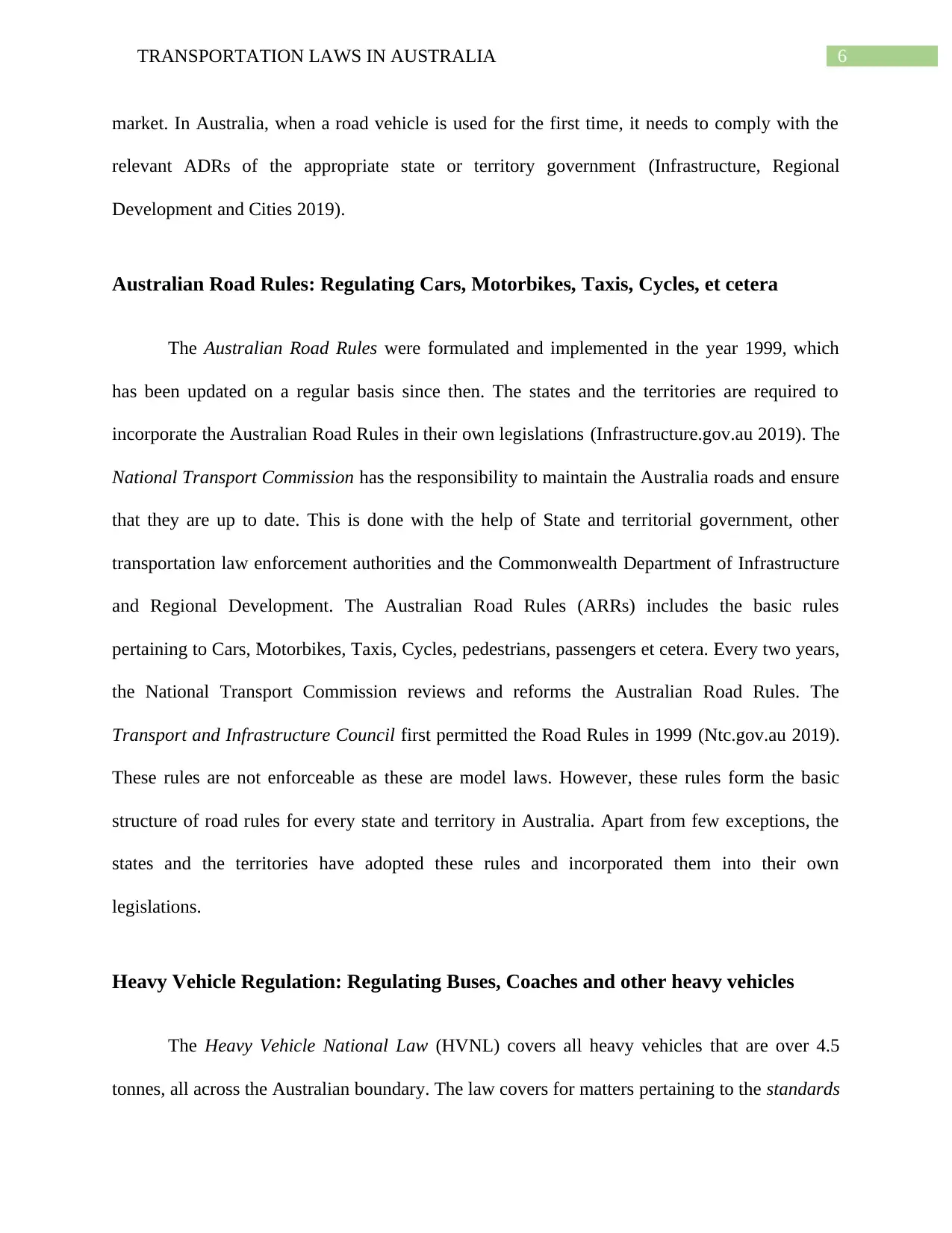
6TRANSPORTATION LAWS IN AUSTRALIA
market. In Australia, when a road vehicle is used for the first time, it needs to comply with the
relevant ADRs of the appropriate state or territory government (Infrastructure, Regional
Development and Cities 2019).
Australian Road Rules: Regulating Cars, Motorbikes, Taxis, Cycles, et cetera
The Australian Road Rules were formulated and implemented in the year 1999, which
has been updated on a regular basis since then. The states and the territories are required to
incorporate the Australian Road Rules in their own legislations (Infrastructure.gov.au 2019). The
National Transport Commission has the responsibility to maintain the Australia roads and ensure
that they are up to date. This is done with the help of State and territorial government, other
transportation law enforcement authorities and the Commonwealth Department of Infrastructure
and Regional Development. The Australian Road Rules (ARRs) includes the basic rules
pertaining to Cars, Motorbikes, Taxis, Cycles, pedestrians, passengers et cetera. Every two years,
the National Transport Commission reviews and reforms the Australian Road Rules. The
Transport and Infrastructure Council first permitted the Road Rules in 1999 (Ntc.gov.au 2019).
These rules are not enforceable as these are model laws. However, these rules form the basic
structure of road rules for every state and territory in Australia. Apart from few exceptions, the
states and the territories have adopted these rules and incorporated them into their own
legislations.
Heavy Vehicle Regulation: Regulating Buses, Coaches and other heavy vehicles
The Heavy Vehicle National Law (HVNL) covers all heavy vehicles that are over 4.5
tonnes, all across the Australian boundary. The law covers for matters pertaining to the standards
market. In Australia, when a road vehicle is used for the first time, it needs to comply with the
relevant ADRs of the appropriate state or territory government (Infrastructure, Regional
Development and Cities 2019).
Australian Road Rules: Regulating Cars, Motorbikes, Taxis, Cycles, et cetera
The Australian Road Rules were formulated and implemented in the year 1999, which
has been updated on a regular basis since then. The states and the territories are required to
incorporate the Australian Road Rules in their own legislations (Infrastructure.gov.au 2019). The
National Transport Commission has the responsibility to maintain the Australia roads and ensure
that they are up to date. This is done with the help of State and territorial government, other
transportation law enforcement authorities and the Commonwealth Department of Infrastructure
and Regional Development. The Australian Road Rules (ARRs) includes the basic rules
pertaining to Cars, Motorbikes, Taxis, Cycles, pedestrians, passengers et cetera. Every two years,
the National Transport Commission reviews and reforms the Australian Road Rules. The
Transport and Infrastructure Council first permitted the Road Rules in 1999 (Ntc.gov.au 2019).
These rules are not enforceable as these are model laws. However, these rules form the basic
structure of road rules for every state and territory in Australia. Apart from few exceptions, the
states and the territories have adopted these rules and incorporated them into their own
legislations.
Heavy Vehicle Regulation: Regulating Buses, Coaches and other heavy vehicles
The Heavy Vehicle National Law (HVNL) covers all heavy vehicles that are over 4.5
tonnes, all across the Australian boundary. The law covers for matters pertaining to the standards
Paraphrase This Document
Need a fresh take? Get an instant paraphrase of this document with our AI Paraphraser

7TRANSPORTATION LAWS IN AUSTRALIA
of the heavy vehicles, mass dimensions, and loading limits, fatigue management of the drivers,
Intelligent Access Program, on-road enforcement and heavy vehicle accreditation. The
Australian Capital Territory has implemented the legislation partially and shall adopt the
remaining parts on a later date. Brisbane-based National Heavy Vehicle Regulator administers
and regulates the law efficiently. The regulator along with the help of National Transport
Commission strives to progress the reforms of the national heavy vehicles (Infrastructure,
Regional Development and Cities 2019).
The HVNL comprises of the following four regulations: (i) Heavy Vehicle (General)
National Regulation, (ii) Heavy Vehicle (Mass, Dimension and Loading) National Regulation,
(iii) Heavy Vehicle (Fatigue Management) National Regulation, and (iv) Heavy Vehicle (Vehicle
Standards) National Regulation. The HVNL Act 2012 has been only passed by the Queensland
Parliament, which is being consulted as a template for implementation for other states in
Australia (Ntc.gov.au 2019). The buses and coaches are governed by the HVNL rules and
regulations. The rules contain the information about the heavy vehicles regarding its loading
limits, mass and dimension, speeding limits and its issues, driver’s fatigue management,
intelligent access, enforcement rules and other administrative functions. Buses and coaches are
also required to comply with the local legislations relating to the passengers, transport standard
and the transport services that they provide, along with following the rules laid down by the
HVNL (Ntc.gov.au 2019).
The National Heavy Vehicle Regulator (NHVR) gives a guideline pertaining to the load
that a heavy vehicle may carry. The load should not be put in such a way that it affects the safe
driving guidelines of the vehicle. The load must be securely loaded in the vehicle so that it does
of the heavy vehicles, mass dimensions, and loading limits, fatigue management of the drivers,
Intelligent Access Program, on-road enforcement and heavy vehicle accreditation. The
Australian Capital Territory has implemented the legislation partially and shall adopt the
remaining parts on a later date. Brisbane-based National Heavy Vehicle Regulator administers
and regulates the law efficiently. The regulator along with the help of National Transport
Commission strives to progress the reforms of the national heavy vehicles (Infrastructure,
Regional Development and Cities 2019).
The HVNL comprises of the following four regulations: (i) Heavy Vehicle (General)
National Regulation, (ii) Heavy Vehicle (Mass, Dimension and Loading) National Regulation,
(iii) Heavy Vehicle (Fatigue Management) National Regulation, and (iv) Heavy Vehicle (Vehicle
Standards) National Regulation. The HVNL Act 2012 has been only passed by the Queensland
Parliament, which is being consulted as a template for implementation for other states in
Australia (Ntc.gov.au 2019). The buses and coaches are governed by the HVNL rules and
regulations. The rules contain the information about the heavy vehicles regarding its loading
limits, mass and dimension, speeding limits and its issues, driver’s fatigue management,
intelligent access, enforcement rules and other administrative functions. Buses and coaches are
also required to comply with the local legislations relating to the passengers, transport standard
and the transport services that they provide, along with following the rules laid down by the
HVNL (Ntc.gov.au 2019).
The National Heavy Vehicle Regulator (NHVR) gives a guideline pertaining to the load
that a heavy vehicle may carry. The load should not be put in such a way that it affects the safe
driving guidelines of the vehicle. The load must be securely loaded in the vehicle so that it does

8TRANSPORTATION LAWS IN AUSTRALIA
not fall off the vehicle. It must be restrained using an appropriate method of restraint. It must be
loaded and restrained in accordance to the loading performance standards as mentioned under the
Heavy Vehicle (Mass, Dimension and Loading) National Regulation (Nhvr.gov.au 2019).
Australian Light Vehicle Standards Rules
The Australian Light Vehicle Standards Rules (ALVSRs) were formulated on the basis of
the Australian Design Rules (ADRs) which are developed and maintained by the
Commonwealth. The ALVSRs requires the vehicles to comply with the ADR, when they are first
built in Australia or imported to the country. The ALVSRs are required to have certain
combinations like dimensional limits, which ADRs does not specify. The Australian Light
Vehicle Standards Rules are reviewed annually by the NTC. The Australian Vehicle Standards
Rules 1999 (AVSRs) replaced the Australian Light Vehicle Standards Rules (ALVSRs) 2015.
The ALVSRs were formulated after consulting the appropriate stakeholders that include road
agencies, police and road safety experts, automotive industry bodies and others. These rules have
no legal effect and they are non-enforceable. However, they form the basis of the legislations
that the state and territories implement in their rules for vehicle standards (Ntc.gov.au 2019).
The Transport Regulatory Authority and the NTC lays down the rules on load restraint on
light vehicles. The vehicles are restrained from carrying a heavy load on a light vehicle so that
the load stays on the vehicle even when there are heavy braking, acceleration, cornering and
minor collision. The load should not negatively affect the vehicle’s stability that might make it
unsafe or difficult to drive. The load must not protrude from the vehicle in such a way that it
would injure a person, restrict other’s passage to move or damage property.
not fall off the vehicle. It must be restrained using an appropriate method of restraint. It must be
loaded and restrained in accordance to the loading performance standards as mentioned under the
Heavy Vehicle (Mass, Dimension and Loading) National Regulation (Nhvr.gov.au 2019).
Australian Light Vehicle Standards Rules
The Australian Light Vehicle Standards Rules (ALVSRs) were formulated on the basis of
the Australian Design Rules (ADRs) which are developed and maintained by the
Commonwealth. The ALVSRs requires the vehicles to comply with the ADR, when they are first
built in Australia or imported to the country. The ALVSRs are required to have certain
combinations like dimensional limits, which ADRs does not specify. The Australian Light
Vehicle Standards Rules are reviewed annually by the NTC. The Australian Vehicle Standards
Rules 1999 (AVSRs) replaced the Australian Light Vehicle Standards Rules (ALVSRs) 2015.
The ALVSRs were formulated after consulting the appropriate stakeholders that include road
agencies, police and road safety experts, automotive industry bodies and others. These rules have
no legal effect and they are non-enforceable. However, they form the basis of the legislations
that the state and territories implement in their rules for vehicle standards (Ntc.gov.au 2019).
The Transport Regulatory Authority and the NTC lays down the rules on load restraint on
light vehicles. The vehicles are restrained from carrying a heavy load on a light vehicle so that
the load stays on the vehicle even when there are heavy braking, acceleration, cornering and
minor collision. The load should not negatively affect the vehicle’s stability that might make it
unsafe or difficult to drive. The load must not protrude from the vehicle in such a way that it
would injure a person, restrict other’s passage to move or damage property.
⊘ This is a preview!⊘
Do you want full access?
Subscribe today to unlock all pages.

Trusted by 1+ million students worldwide
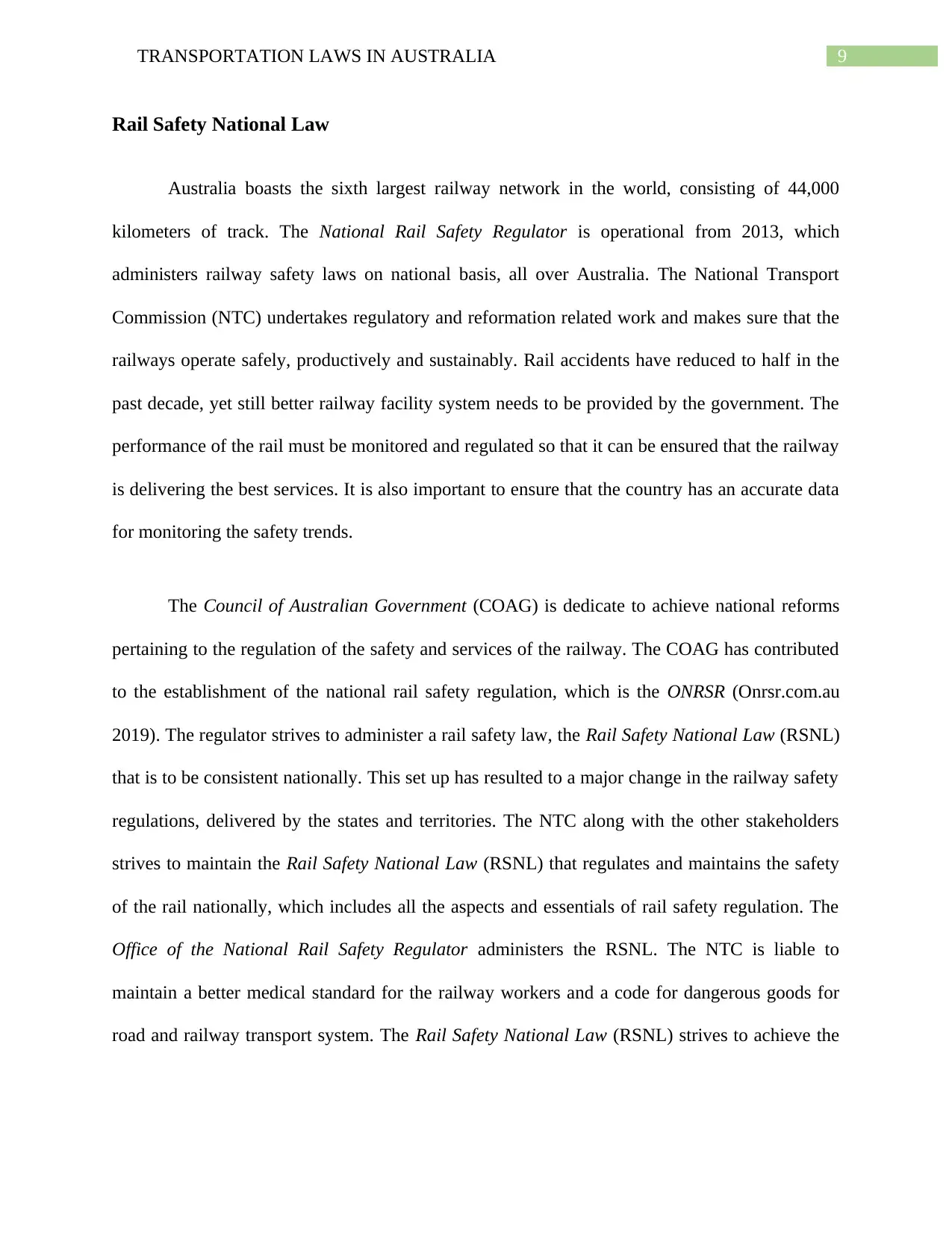
9TRANSPORTATION LAWS IN AUSTRALIA
Rail Safety National Law
Australia boasts the sixth largest railway network in the world, consisting of 44,000
kilometers of track. The National Rail Safety Regulator is operational from 2013, which
administers railway safety laws on national basis, all over Australia. The National Transport
Commission (NTC) undertakes regulatory and reformation related work and makes sure that the
railways operate safely, productively and sustainably. Rail accidents have reduced to half in the
past decade, yet still better railway facility system needs to be provided by the government. The
performance of the rail must be monitored and regulated so that it can be ensured that the railway
is delivering the best services. It is also important to ensure that the country has an accurate data
for monitoring the safety trends.
The Council of Australian Government (COAG) is dedicate to achieve national reforms
pertaining to the regulation of the safety and services of the railway. The COAG has contributed
to the establishment of the national rail safety regulation, which is the ONRSR (Onrsr.com.au
2019). The regulator strives to administer a rail safety law, the Rail Safety National Law (RSNL)
that is to be consistent nationally. This set up has resulted to a major change in the railway safety
regulations, delivered by the states and territories. The NTC along with the other stakeholders
strives to maintain the Rail Safety National Law (RSNL) that regulates and maintains the safety
of the rail nationally, which includes all the aspects and essentials of rail safety regulation. The
Office of the National Rail Safety Regulator administers the RSNL. The NTC is liable to
maintain a better medical standard for the railway workers and a code for dangerous goods for
road and railway transport system. The Rail Safety National Law (RSNL) strives to achieve the
Rail Safety National Law
Australia boasts the sixth largest railway network in the world, consisting of 44,000
kilometers of track. The National Rail Safety Regulator is operational from 2013, which
administers railway safety laws on national basis, all over Australia. The National Transport
Commission (NTC) undertakes regulatory and reformation related work and makes sure that the
railways operate safely, productively and sustainably. Rail accidents have reduced to half in the
past decade, yet still better railway facility system needs to be provided by the government. The
performance of the rail must be monitored and regulated so that it can be ensured that the railway
is delivering the best services. It is also important to ensure that the country has an accurate data
for monitoring the safety trends.
The Council of Australian Government (COAG) is dedicate to achieve national reforms
pertaining to the regulation of the safety and services of the railway. The COAG has contributed
to the establishment of the national rail safety regulation, which is the ONRSR (Onrsr.com.au
2019). The regulator strives to administer a rail safety law, the Rail Safety National Law (RSNL)
that is to be consistent nationally. This set up has resulted to a major change in the railway safety
regulations, delivered by the states and territories. The NTC along with the other stakeholders
strives to maintain the Rail Safety National Law (RSNL) that regulates and maintains the safety
of the rail nationally, which includes all the aspects and essentials of rail safety regulation. The
Office of the National Rail Safety Regulator administers the RSNL. The NTC is liable to
maintain a better medical standard for the railway workers and a code for dangerous goods for
road and railway transport system. The Rail Safety National Law (RSNL) strives to achieve the
Paraphrase This Document
Need a fresh take? Get an instant paraphrase of this document with our AI Paraphraser
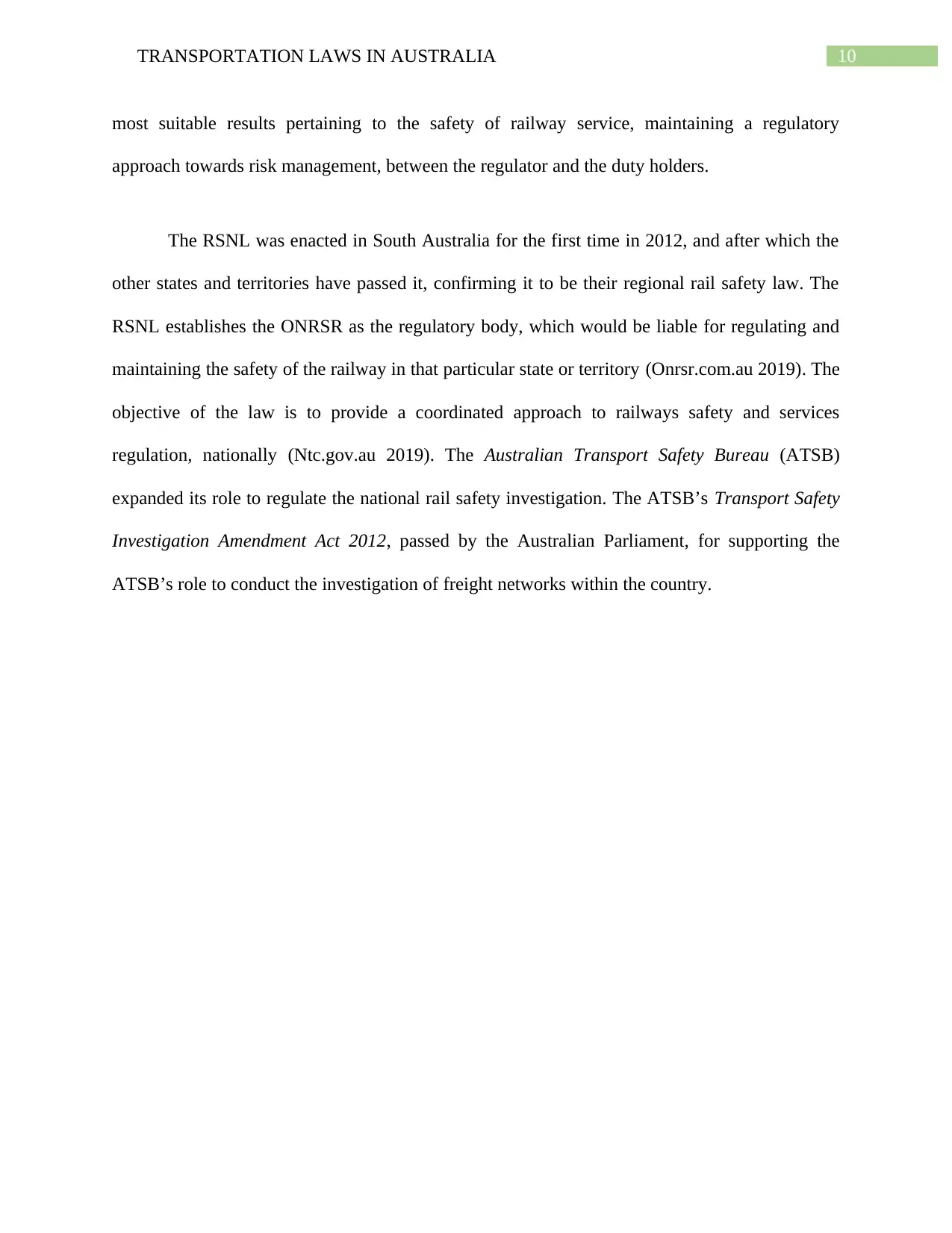
10TRANSPORTATION LAWS IN AUSTRALIA
most suitable results pertaining to the safety of railway service, maintaining a regulatory
approach towards risk management, between the regulator and the duty holders.
The RSNL was enacted in South Australia for the first time in 2012, and after which the
other states and territories have passed it, confirming it to be their regional rail safety law. The
RSNL establishes the ONRSR as the regulatory body, which would be liable for regulating and
maintaining the safety of the railway in that particular state or territory (Onrsr.com.au 2019). The
objective of the law is to provide a coordinated approach to railways safety and services
regulation, nationally (Ntc.gov.au 2019). The Australian Transport Safety Bureau (ATSB)
expanded its role to regulate the national rail safety investigation. The ATSB’s Transport Safety
Investigation Amendment Act 2012, passed by the Australian Parliament, for supporting the
ATSB’s role to conduct the investigation of freight networks within the country.
most suitable results pertaining to the safety of railway service, maintaining a regulatory
approach towards risk management, between the regulator and the duty holders.
The RSNL was enacted in South Australia for the first time in 2012, and after which the
other states and territories have passed it, confirming it to be their regional rail safety law. The
RSNL establishes the ONRSR as the regulatory body, which would be liable for regulating and
maintaining the safety of the railway in that particular state or territory (Onrsr.com.au 2019). The
objective of the law is to provide a coordinated approach to railways safety and services
regulation, nationally (Ntc.gov.au 2019). The Australian Transport Safety Bureau (ATSB)
expanded its role to regulate the national rail safety investigation. The ATSB’s Transport Safety
Investigation Amendment Act 2012, passed by the Australian Parliament, for supporting the
ATSB’s role to conduct the investigation of freight networks within the country.

11TRANSPORTATION LAWS IN AUSTRALIA
Taxi v. Uber
The Australian transportation has witnessed an innumerable amount of controversies
regarding the conflict between taxi and uber. Uber is allegedly taking over an enormous portion
of the market from taxi. However, there are considerable amount of hurdles that have been faced
by the uber from time to time. There is a constant quest of supremacy between the taxi and uber.
Sometimes, the escalated prices of the taxi are criticised and compared with discounted prices of
the uber. On other instances, the operating of uber cars without a license has been condemned.
The surge pricing in uber have been put to consideration in certain cases too. Taxi society has
brought protest movements against uber many times. However, the supremacy of both the modes
of transportation over the other requires a thorough consideration.
Case 1: Survey Comparing the Safety, Reliability and Costs
A survey was carried out by a group of consumers to compare the safety, reliability and
costs of the taxi rides with uber rides. In ninety percent of the times, the cost of uber is cheaper
than that of taxi. The taxi fares are found to be forty percent expensive than uber fares on an
average. This renders uber to be a more pocket-friendly mode of transportation than taxis. There
were protests by the taxi drivers about the same (Glöss, McGregor and Brown 2016). However,
the taxi owners have in several times pointed out the surge pricing of uber. The taxi owners have
portrayed the surge pricing to be heavy in the pockets. It can be observed that surge pricings are
the escalation of fares by the uber during the night or other times. The surge pricings are imposed
owing to high demand. During the times of high demand of uber cars the company imposes a
high price to meet the increasing demand of the same. Moreover, during the times of surge
pricings the uber fares have been escalated to a maximum of six percent more than the taxi fares.
Taxi v. Uber
The Australian transportation has witnessed an innumerable amount of controversies
regarding the conflict between taxi and uber. Uber is allegedly taking over an enormous portion
of the market from taxi. However, there are considerable amount of hurdles that have been faced
by the uber from time to time. There is a constant quest of supremacy between the taxi and uber.
Sometimes, the escalated prices of the taxi are criticised and compared with discounted prices of
the uber. On other instances, the operating of uber cars without a license has been condemned.
The surge pricing in uber have been put to consideration in certain cases too. Taxi society has
brought protest movements against uber many times. However, the supremacy of both the modes
of transportation over the other requires a thorough consideration.
Case 1: Survey Comparing the Safety, Reliability and Costs
A survey was carried out by a group of consumers to compare the safety, reliability and
costs of the taxi rides with uber rides. In ninety percent of the times, the cost of uber is cheaper
than that of taxi. The taxi fares are found to be forty percent expensive than uber fares on an
average. This renders uber to be a more pocket-friendly mode of transportation than taxis. There
were protests by the taxi drivers about the same (Glöss, McGregor and Brown 2016). However,
the taxi owners have in several times pointed out the surge pricing of uber. The taxi owners have
portrayed the surge pricing to be heavy in the pockets. It can be observed that surge pricings are
the escalation of fares by the uber during the night or other times. The surge pricings are imposed
owing to high demand. During the times of high demand of uber cars the company imposes a
high price to meet the increasing demand of the same. Moreover, during the times of surge
pricings the uber fares have been escalated to a maximum of six percent more than the taxi fares.
⊘ This is a preview!⊘
Do you want full access?
Subscribe today to unlock all pages.

Trusted by 1+ million students worldwide
1 out of 20
Related Documents
Your All-in-One AI-Powered Toolkit for Academic Success.
+13062052269
info@desklib.com
Available 24*7 on WhatsApp / Email
![[object Object]](/_next/static/media/star-bottom.7253800d.svg)
Unlock your academic potential
Copyright © 2020–2025 A2Z Services. All Rights Reserved. Developed and managed by ZUCOL.




